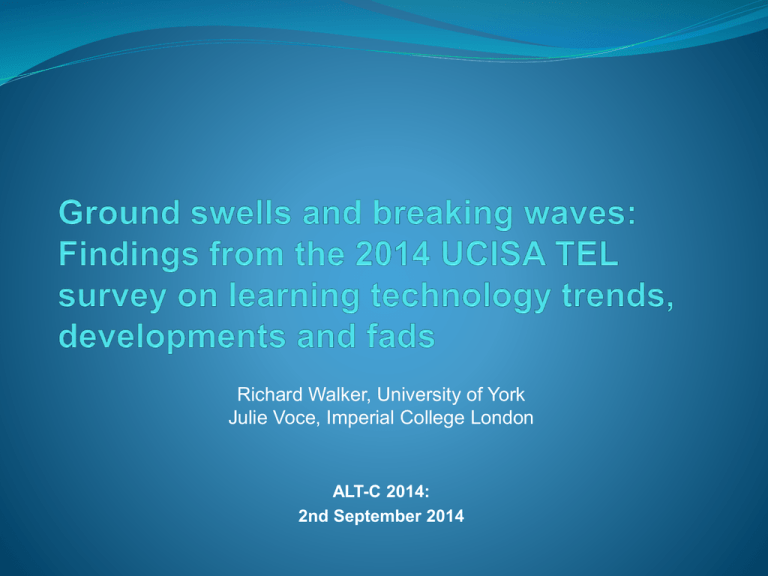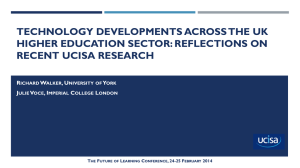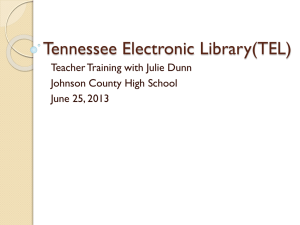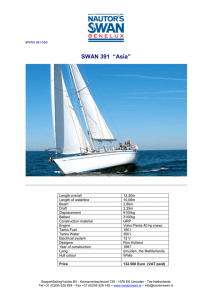UCISA TEL Survey 2012
advertisement

Richard Walker, University of York Julie Voce, Imperial College London ALT-C 2014: 2nd September 2014 About the UCISA TEL Survey National survey into TEL undertaken by UCISA, with backing from the UK Heads of e-Learning Forum. Running biennially since 2001: www.ucisa.ac.uk/tel 2010, 2012 and 2014 reports supported by case studies, enabling investigation of themes such as QA & TEL governance. The 2014 Survey 96 responses from 158 HE institutions (Response rate 61%) Good spread of responses across the UK (by country, by mission group and by type of institution, i.e. Pre-92, Post-92 and HE Colleges) Sent out to institutional Heads of e-Learning in January 2014 Not getting same cohort each time; but results do show consistency 1. Drivers for TEL development The student learning experience is driving TEL developments and student feedback is the leading encourager. Open education (MOOCs) is not making headway and is the lowest ranked driver. Drivers for TEL Top ranked drivers (2003 – 2014) 1. 2. 3. Enhancing the quality of learning and teaching Meeting student expectations Improving access to learning for students off-campus Improving admin processes rises to 4th place; improving access to DL has dropped down list. Bottom of the pile: provision of OERs & open education courses (MOOCs). Encouraging TEL development 1. Feedback from students 2. Availability of TEL support staff 3. Availability and access to tools Central & school/departmental senior management support also strongly ranked. Standards & availability of external project funding at bottom of list 2. Barriers to TEL development Lack of academic staff knowledge has reemerged as a leading barrier to TEL development. Barriers to future development Lack of time (still the most significant barrier) Longitudinal view of the top 7 of 16 rankings Barriers – lack of… 2014 2012 2010 2008 2005 2003 Time 1 1 1 1 1 2 Academic staff knowledge 2 5 3 2 7 4 Money 3 2 2 3 2 1 Institutional culture 4 8 7 4 8 - Departmental/school culture 5 3 - - - - Incentives 6 7 6 8 5 8= Academic staff commitment 7= 6 5 - - - Recognition for career dev. 7= 4 4 6 4 - 3. Challenges to TEL development Despite the slight increase in the number of learning technologists working in central and local teams since 2012, institutions perceive a lack of specialist support staff as the leading challenge to future TEL development activities. Challenges to TEL development Challenges over the next two to three years 1. Lack of support staff / specialists skills / resources 2. Mobile technologies/learning: BYOD (support, creating content & compatibility with systems) 3. Staff development 4. E-assessment (e-submission, e-marking, e-feedback) 5. Lecture capture / recording 4. Institutional VLEs All institutions have a VLE platform and Blackboard remains the leading enterprise solution, with Moodle the most-used system. A third of responding institutions now outsource their VLE provision. TEL tools – VLEs Institutional VLE 88% of respondents use either Blackboard or Moodle as their main institutional platform (unchanged from 2012). Blackboard Learn remains the leading enterprise solution (49%); Moodle has increased in usage (up from 11% in 2008 to 31% in 2012 and now 39% - 2014). Overall VLE use Moodle is the most commonly used VLE platform (62%); followed by Blackboard Learn (49%). Negligible use of other open source & commercial solutions: e.g. Sharepoint (12%); FutureLearn (5%); Sakai (2%); Desire2Learn (2%) 33% of institutions are using hosted services for their VLE provision. 5. Centrally-supported tools Plagiarism detection and e-submission tools are the most commonly supported services. Podcasting tools appear to have been replaced by lecture recording and media streaming solutions. TEL tools - centrally supported Tool VLE Plagiarism detection E-submission E-portfolio Blog E-assessment PRS / clickers Wiki Media streaming Lecture capture 2014 95%* 2012 100% 2010 2008 96% 95% 92% 92% - 85% 78% 73% 71% 70% 66% 65% 63% 87% 76% 72% 79% 74% 51% 89% 72% 74% 80% 75% - 68% 72% 64% - Proportion of courses using tools Tool Access to external web based resources E-submission Plagiarism detection Formative e-assessment Summative e-assessment Audio / Video lecture recording Document sharing Online student presentations Asynchronous collaborative working tools 100% 75% - 99% 50% - 74% 8% 35% 12% 6% 5% 5% 2% 2% 1% 1% 34% 31% 1% 5% 1% 2% 2% 22% 34% 16% 4% 5% 6% 6% 0% 7% 19% 6. Non-centrally supported tools Social networking tools are the leading noncentrally supported software used by students but are no longer a feature of central provision. TEL tools – not centrally supported Tool Social networking Document sharing Blog Social bookmarking Media streaming Personal RS Screen casting Podcasting VLE e-Portfolio Lecture capture Wiki 2014 64% 62% 59% 31% 26% 26% 26% 21% 20% 19% 19% 17% 2012 73% 52% 60% 40% 22% 21% 23% 20% 36% 2010 81% 59% 48% 41% 23% 25% 51% 2008 46% 30% 31% 26% 11% 34% 7. Mobile learning developments The optimisation of learning and teaching services for mobile devices has increased in scale, with a strong focus on communication and information services for iOS and Android devices. However, only a handful of institutions have addressed pedagogic initiatives and staff development activities in support of mobile learning. Services optimised for mobile devices Service 2014 2012 Access to email 64% 35% Access to course materials & learning resources 62% 21% Access to course announcements 60% 31% Access to communication tools 48% 20% Access to library services 43% 37% Access to lecture recordings & videos 39% 13% Access to grades 29% 12% Access to personal calendars 29% 21% Access to timetabling information 28% 26% Promotion of mobile devices Promotion method Loaning of devices to staff & students Funding for mobile learning projects Free provision of devices to staff / students Institutional switch-on policy Other method Do not promote use of mobile devices % 42% 35% 18% 17% 30% 24% 8. Role of TEL in module delivery Supplementary uses of TEL tools remain the leading module delivery mode and unchanged in number since the last Survey. Content-focused categories of TEL course delivery have accounted for two-thirds of module delivery since 2003. Categories of TEL usage A: Web-supplemented (optional participation) Bi: Web-dependent: Interaction with content Bii: Web-dependent: Communication Biii: Web-dependent: Interaction with content & communication C.: Fully online 2014 2012 2010 2008 2005 2003 39% 39% 46% 48% 54% 57% 27% 29% 26% 24% 16% 13% 9% 10% 17% 13% 10% 10% 21% 18% 18% 13% 13% 13% 3% 3%- 3% 4% 6% 5% 9. Evaluation of TEL developments Half of responding institutions have evaluated the impact of TEL tools on the student learning experience, but less than a third have evaluated pedagogic practices. Accessing the Report The 2014 Survey report is now available on the UCISA website at: www.ucisa.ac.uk/tel Case studies of institutional TEL developments will be published in a companion report, targeted for publication by the end of the year. Comparative analysis is planned with the Irish Learning Technology Association. Feedback on the Report (question-set and findings) would be greatly appreciated to inform future surveys. Please join the M25-LT & East Midlands LT SIG meeting this afternoon (4pm in room 0.13) for further discussion on the Survey results and how they may apply to your institutional context. Acknowledgements and thanks To the Survey team: Joe Nicholls (University of Cardiff); Elaine Swift (Nottingham Trent University); Jebar Ahmed (University of Huddersfield); Sarah Horrigan (University of Derby); Phil Vincent (York St John University); Julie Voce (Imperial College London) & Richard Walker (University of York), with help from Martin Jenkins (Coventry University) and Nick Smith (The Research Partnership). To the UCISA Executive & Operational Support Team. To UK Heads of e-Learning Forum (HeLF) members To UCISA Academic Support Group members











